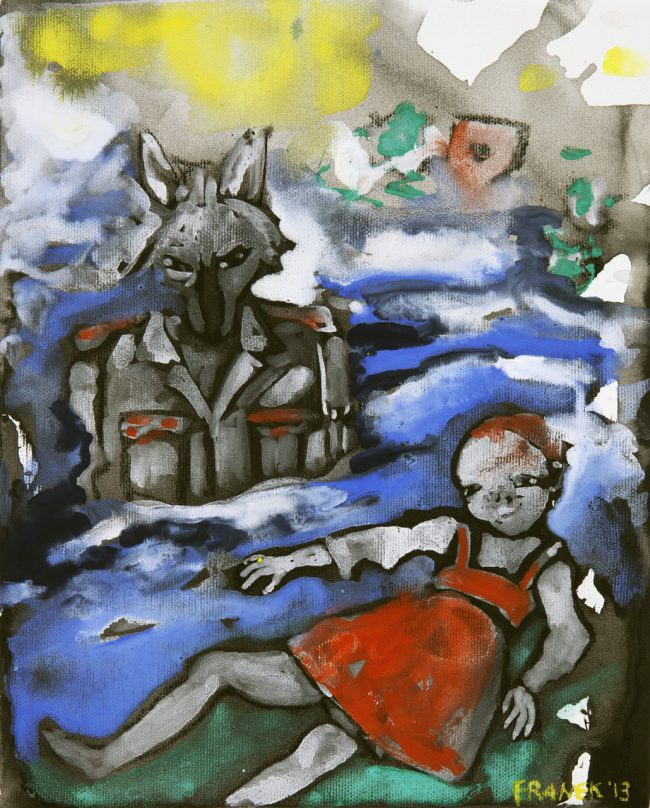Eckhart Gillen als die Soldaten Schäfer waren (when the soldiers were shepherds)
Opening Speech, September 6, 2015, Kommunale Galerie Berlin
“On September 1st, 1939, the mother called the father, at that time a general staff officer in Potsdam, and said, ‘It´s starting!’ to which he replied, ‘I´ve known that for two hours.’ She was talking about your birth, he, about the beginning of World War Two.’
This dialogue from the publication, als die Soldaten Schäfer waren (when the soldiers were shepherds) was written by FRANEK, who was literally born into that war. Seventy years after it was over she raises the questions, “Is there a relationship between my childhood and my art?” Why have the warring attributes that often appear in my paintings crept in? Where have the girls in arms, child soldiers, fighter jets and drones come from? Furthermore, just when it starts appearing paradisiacal, calamities that were initially obscured rear their head. Additionally, there is evil lurking in the childhood paintings.” All of these works are a cryptic commentary on your childhood.
Not only does your oeuvre integrate life and work through ever recurring motifs, but you also devise iconographic children in the midst of a world of military, weapons, threats from planes and bombs …
You mention that your “Paintings are created from memories”. Nonetheless you describe your memories of the time during and after the Second World War as being, comparable to all memories, “vague and unclear traces of thoughts and images which not unlike a faultily archived black and white film, blur into one another.”
In another passage you speak of what you call your Wunderkammer: these bricolages on plywood, fifteen of which were created in 2012. This Wunderkammer is, “a reservoir of memories as well as an examination in the past “ that consists of banished bricolages on black. On October 16, 2012 you add the note: MNEMOSYNE.
Across all your works, but in particular the 2013 series of “childhood paintings” it becomes apparent how central the act of remembering is. Underpinned by the emotional experiences post and during the war – and depicted in your diaries – the paintings reveal imagery from your unconscious, which is then transformed, reinvented and painted over.
For this series you used Fermacell boards, which are usually used in wall construction. In contrast to painting on canvas, which yields, these boards are extremely sturdy and heavy and offer resistance to your spatula, brush and pen. You work on these boards in layers and like a palimpsest; layers of memory are released but also covered over with others. Vividly, you describe the process, “The first layer is the scraping and sanding, the second involves the drawing and the third involves the inks in which the work develops its colour. In between all of this the scraping technique is always present. Sometimes I push things away with my spatula by glazing and then I may draw over this again. In doing so there are no real blacks created and instead always slightly grey. The process can be likened to the process of remembering and I’ve only become aware of this in the midst of painting: in remembering one is always searching and even if it often seems that memory has gone to the dogs, suddenly there it is and an image appears. This image subsequently calls forth others, the first image disappears, sometimes it reappears, or the associative pictures unexpectedly become vivid and replace the previous ones. This process occurs on various levels and is not unlike working in Photoshop: the more layers, the more complex the image. It is this complex layering that creates a dense web of structures, unforeseen shades of colour and an opaque depth.”
......
Red Riding Hood and the Father
In many of your paintings such as the 2013, Deluge-Radegast (Rotkäppchen) [Radegast Deluge (Red Riding Hood)], which was painted in the same year as the childhood paintings, Red Riding Hood appears helpless but smiling, reclining on a tidal wave and under scrutiny by a wolf in an epauletted uniform. On an errand from the mother to the grandmother, the naive, curious girl is deceived by the wolf that devours the grandmother and in her guise then also consumes Red Riding Hood. The hunter frees both women from the wolf’s abdomen (midwife, obstetrician) and replaces them with rocks, which results in the wolf’s death.
The father as masculine principle divides himself into an aggressive wolf as well as the victim of a heroic hunter. Called to war as a wolf in uniform, in your imagination he ought to have protected the herd/family as a shepherd/hunter.
Despite that the mother was the most important caregiver offering security and protection during chaotic times, the absent father embodies a secret, which also makes him attractive, given that it remains unresolved how the father dealt with his wounds and psychological trauma.
Eckhart Gillen: Excerpts from the opening address to the exhibition, ‘FRANEK als die Soldaten Schäfer waren (when the soldiers were shepherds), Kommunale Galerie Berlin, 2015

